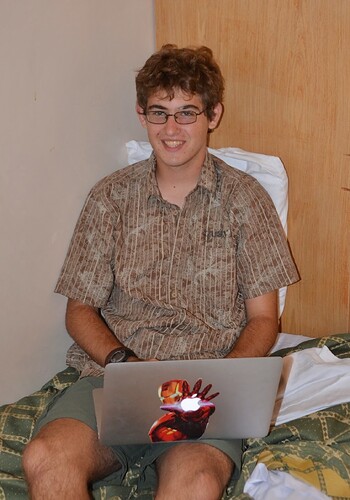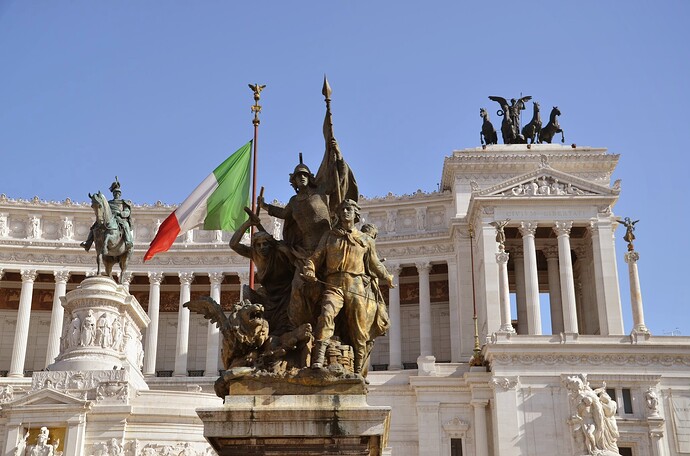On our second day in Rome, we decided to visit the Colosseum. Our hotel was conveniently located near the train station, but given the vast size of Rome, we chose to use the subway/metro for transportation. Unlike in Paris, where buying a multi-day pass didn’t save us money and resulted in a collection of single-use tickets, in Rome, we opted for two-day passes.
That morning, we successfully navigated to the ‘Colosseo’ stop. To our delight, upon exiting the station, we found ourselves right next to the Colosseum. However, our initial excitement was quickly replaced by worry about the ancient structure. Despite the constant rumbling and vibrations from the passing trains, the seemingly delicate ruins appeared undisturbed.
We purchased tickets for a tour in English that ended inside a museum filled with models showing the former glory and amazing construction.
The Roman Forum is right across the street from the Colosseum. This was a very warm self-guided walking tour. All the temples and historic sites are marked in multiple languages. Knowing Latin would have been helpful. Keira documented this area especially well with her red camera.
Travel Technology
Among our tech gear, we brought an older MacBook Air laptop, and it worked great. We used it to write the travel log and offload and sort pictures from the 3 cameras. Just prior to this trip 10 years ago, I upgraded my laptop and gave this one to Kenny. It was probably 5+ years old at the time, and as of 2023, he still has it and uses it on occasion. The trackpad no longer works, but the unit is fully functional with a USB mini-mouse.
Among the three cameras was the Nikon D7000 along with the amazing Tameron 18-270 zoom lens. Every bit of that lens range got used from the wide angle shots with limited space to shots of statues on the tops of buildings with the extended zoom. Check back later and I’ll provide a link to a detailed post on this camera.
The two small cameras were of the Nikon Coolpix family. These fine little cameras use secure-digital cards and AA batteries. The cards pop into a slot on the Mac and the batteries are easily replaced. Making the same trip today, we would simply use our smartphone cameras. For the 2013 trip, we bought a couple of regional sim cards to support a couple of business meetings.
We have since changed to the Google Fi network and our phones work great in Europe. Ask us about the Crypto Currency Developers Conference in Prague!
Roman Arch Technology
Those Romans love arches because they are strong!
Roman Colosseum (Flavian Amphitheatre)
The Roman Colosseum, also known as the Flavian Amphitheatre, is an iconic symbol of Imperial Rome. Construction began under Emperor Vespasian in 72 AD and was completed by his son, Titus, in 80 AD. The colossal structure, capable of seating around 50,000 spectators, was primarily used for gladiatorial contests, public spectacles, and dramas based on Classical mythology.
The Colosseum was a testament to Roman engineering prowess, with its complex system of vaults, arches, and concrete. It featured a retractable awning, or “velarium,” manipulated by a team of sailors to provide shade for spectators. Below the arena floor lay the hypogeum, a network of tunnels and cages where gladiators and animals were kept before contests.
Despite its grandeur, the Colosseum also witnessed the brutality of the Roman Empire, with countless gladiators and wild animals meeting their end within its walls. It was in use for over four centuries, but with the decline of the Roman Empire, the Colosseum fell into disrepair, serving variously as a quarry, a fortress, and a Christian shrine.
The Roman Forum
The Roman Forum, or Forum Romanum in Latin, was the heart of the Roman Empire, bustling with life and activity for over a millennium. Its origins date back to the 7th century BC, when the Romans drained marshy land between the Palatine and Capitoline hills to create a marketplace. Over time, it evolved into the social, political, and commercial hub of the Roman Empire, adorned with grand temples, basilicas, and public spaces.
The Forum witnessed the rise and fall of the Roman Empire, hosting triumphal processions, public speeches, criminal trials, and gladiatorial matches. It was the site of Marc Antony’s eulogy for Julius Caesar and the location of the Vestal Virgins’ sacred hearth.
However, with the fall of the Western Roman Empire in the 5th century AD, the Forum fell into decay. Over centuries, it was plundered for its marble and stone, buried under sediment, and forgotten. It wasn’t until the 18th and 19th centuries that extensive archaeological excavations began, unearthing the Forum’s historical treasures.
In her exploration, Keira found the final resting place of Julius Cesare, the Temple of Divus Iulius. It’s notable that no tomb, or sarcophagus marks the spot, just a mound of dirt that is protected from the elements. He was hated for claiming to be God while ruthlessly ruling. His assassination was no surprise to anyone but maybe him. It’s a fine line to walk with historic preservation between honoring the dead with fancy monuments and preserving history if they are not worthy of honor. It’s important to not re-write history to eliminate the people and events that we did not admire but made a truthful impact on history nonetheless.
The ongoing restoration process was impressive.
The valley was very hot, but as we climbed the hill, breezes picked up. The trees and the views graced ruins that were spaced farther apart. From the top, we could look back toward the Colosseum and out over parts of the city.
OMG, Rome in July can be so hot. We were so pleased to find a place to sit and cool off.
July in Rome can be HOT. Do your exploring in the early morning if you can to avoid the heat and the crowds, otherwise consider a visit in the spring or fall.
Monument to Victor Emmanuel II
Museo Nazionale di Castel Sant’Angelo
Supreme Court of Cassation (Italy)
Double Decker Bus Tour
After the extended hike around the Forum, we decided to take a bus tour for the rest of the city. We were on the top of a double-decker! The breeze and seats were as welcome as the English narration provided by the guide. Normally when hitting a new city we do the bus tour first, to get the layout of the land, this time we did it a different way.
Dinner at the Colosseum
We were holding overnight tickets and had already checked out of our hotel. For dinner, we headed back to the Colosseum where we found a bar with an incredible view that somehow all the other tourists had missed. There was a hot appetizer bar and drinks. while we were waiting for the appointed time to move to the train station. Try as we might, the challenging lighting made it hard to capture the beauty that we could quite clearly see. Parked on the street below our balcony was a car with - you guessed it- another bride and groom taking advantage of the same view. We hope that the wedding photographer had better luck.

Off we go to Germany via another overnight train so I’ll say arrivederci for now.






























